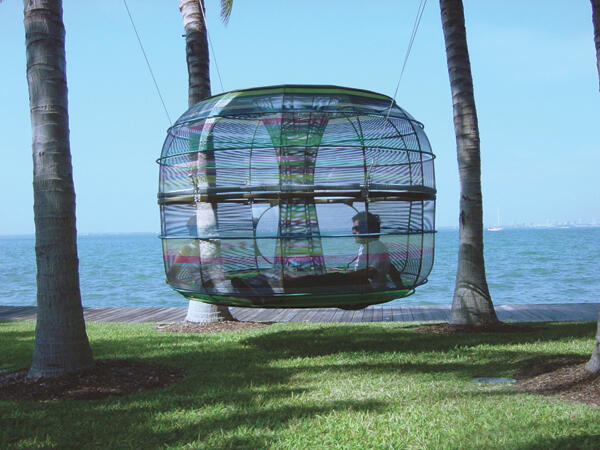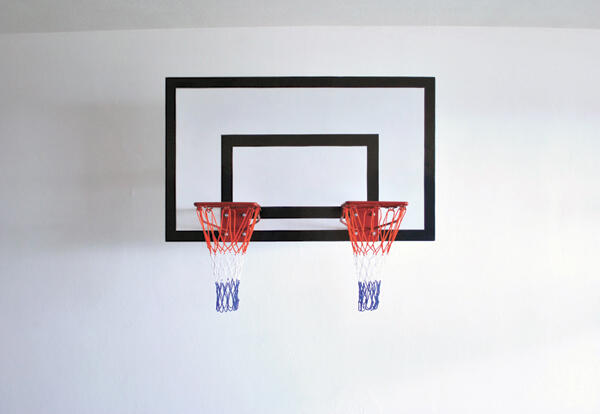MoLAA presents: “Play with Me”
The Museum of Latin American Art, MoLAA presents Play with Me (June 16 – September 2, 2012) featuring engaging installations that encourage visitors to “touch the art”. The exhibition explores the interactive potential of contemporary installation art. Co-curated by Cecilia Fajardo-Hill, Idurre Alonso and Selene Preciado, the exhibition seeks to break down barriers so that contemporary art can be experienced by the viewer as being approachable and engaging.

Play with Me features 13 medium and large scale installations by 12 contemporary Latin American artists interested in the interaction and the relationship between the object and the spectator: Alberto Baraya (Colombia), Franklin Cassaro (Brazil), Cubo (Mexico/US), Dream Addictive (Mexico/Leslie García and Carmen González), Felipe Ehrenberg(Mexico), Darío Escobar (Guatemala), Federico Herrero (Costa Rica), Rafael Lozano-Hemmer (Mexico), Ernesto Neto (Brazil), Rivane Neuenschwander (Brazil), Rubén Ortiz-Torres (Mexico), Pedro Reyes (Mexico), and Sofía Táboas (Mexico).
The installations in Play with Me are meant to be thought-provoking, unconventional and playful environments that engage the viewer while they challenge the way in which traditional mediums such as painting, for example, are perceived. Going beyond the established conventions and breaking down barriers between the viewer, the work of art and the institution, these installations allow an immersive experience within the artwork itself as opposed to observing it from a distance as an object within an enclosed picture plane.
Although all of the works in the exhibition encompass some form of critical thinking, some promote a type of interactivity which is playful and imaginative. Franklin Cassaro created an "inflatable” titled Abrigo Freud (Freud Shelter), a large tent like structure made out of pages of a book by Sigmund Freud. The inflatable is activated by the movement of air, whether from an electric fan or the wind, and can be entered by the visitor. 0 to 0, by Darío Escobar consists of an unusual basketball court where the public will be able to play inside the museum. Federico Herrero translates the mix of colors, shapes, and forms of the streets of San José, Costa Rica—and the tropical landscape that surrounds the city, onto gallery walls. Herrero will take over space in the Museum lobby and a space in the galleries so that the spectator will be able to interact with the pictorial space. Rubén Ortiz-Torres uses paint that changes color when heat is applied to it, so when the spectator touches the piece with a hand for example, it will leave a temporary imprint in its surface. Va de retro (Sombras nada más) / Going Retro (Only Shadows), by Felipe Ehrenbergis an empty “frame” made of tape which mimics the size and shape of classical painted portraits that show the subject’s head and shoulders. The spectator will stand in front of the frame and the shadow of their silhouette will be reflected inside it.
Three Religions, No God and the Children by Ernesto Neto, originally presented at MOCA, consists of a sculptural installation of translucent fabric and textures in which visitors can enter through three openings that lead to a variety of interactive spaces, providing stimuli for the senses and the mind. Pedro Reyes’ interactive, sculptural Capulas are part of an ongoing series that has travelled around the world. Woven by Mexican craftspeople, these vinyl interactive sculptures translate local basketry techniques into an architectural scale. Designed to be malleable structures, the Capulas promote interaction between the piece and the people sitting inside it. Sofía Táboas presents a suspended garden on the interior of MOLAA’s glass façade that will develop and grow as people participate by adding their own potted plants. To establish an interesting dialogue with nature and our surroundings, Expedition California, the project by Alberto Baraya will consist of a 2-part installation with a herbarium of artificial plants brought to the museum by the community and the other by artificial plants that he will collect and classify as a way to participate in a post-colonial discourse and deconstruct the concept of the explorer.
Inviting more critical interactions are installations such as MediaWomb,2009, by the collective Cubo, a small group of artists and cultural producers active in the border region whose work addresses issues such as the loss of public space, the decomposition of social networks, and the prevalence of media as an arena of domination, reproduction and distribution of fear and paranoia. In Watchworld, a work by Brazilian artist Rivane Neuenschwander, museum visitors will be able to affix fabric tags with embroidered words to a panel or take the tags with them. The panel contains the latitudes and longitudes of the world and thus people will decide to attach the labels according to their own geographical identification or the political context. Deep Thought V.2, by Dream Addictive, is an interactive work which highlights the possible dialogue between the reality of the audience and the simulation provided by machines. Voz Alta, by Rafael Lozano-Hemmer, is a memorial commissioned for the 40th anniversary of the student massacre in Tlatelolco, which took place in Mexico City on October 2, 1968. In the piece, participants speak freely into a megaphone placed on the "Plaza de las Tres Culturas," right where the massacre took place. The megaphone is a replica of the one used in the public art piece, except it has been modified to incorporate a powerful xenon searchlight inside, so that when someone speaks into it, his or her voice gets converted into light flashes.
EXHIBITION RELATED EVENT
Panel Discussion
Sunday, June 17, 2:00 – 4:00pm
Free Admission
Enjoy a panel discussion about Play with Me with curators and artists Alberto Baraya, Federico Herrero, Darío Escobar, Sofía Táboas, Nina Waisman, and Leslie García.







